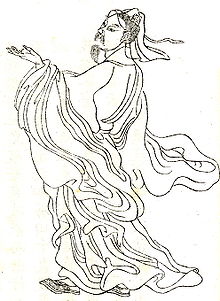
Back গু কাইঝি Assamese Гу Кайчжы Byelorussian Gu Kaizhi Catalan Ku Kchaj-č’ Czech Gu Kaizhi Welsh Gu Kaizhi German Gu Kaizhi Spanish Gu Kaizhi French Ku Kaj-cse Hungarian Gu Kaizhi ID

Gu Kaizhi (simplified Chinese: 顾恺之; traditional Chinese: 顧愷之; pinyin: Gù Kǎizhī; Wade–Giles: Ku K'ai-chih; c. 344–406), courtesy name Changkang (長康), was a Chinese painter and politician. He was a celebrated painter of ancient China.[1] He was born in Wuxi and first painted at Nanjing in 364. In 366, he became an officer (Da Sima Canjun or Assistant to the Minister of Defense, 大司馬參軍). Later he was promoted to royal officer (Sanji Changshi or Gentleman in Waiting to the Emperor, 散騎常侍). He was also a talented poet and calligrapher. He wrote three books about painting theory: On Painting (畫論), Introduction of Famous Paintings of Wei and Jin Dynasties (魏晉勝流畫贊) and Painting Yuntai Mountain (畫雲台山記). He wrote: "In figure paintings the clothes and the appearances were not very important. The eyes were the spirit and the decisive factor."[1]
Gu's art is known today through copies of several silk handscroll paintings attributed to him.
© MMXXIII Rich X Search. We shall prevail. All rights reserved. Rich X Search